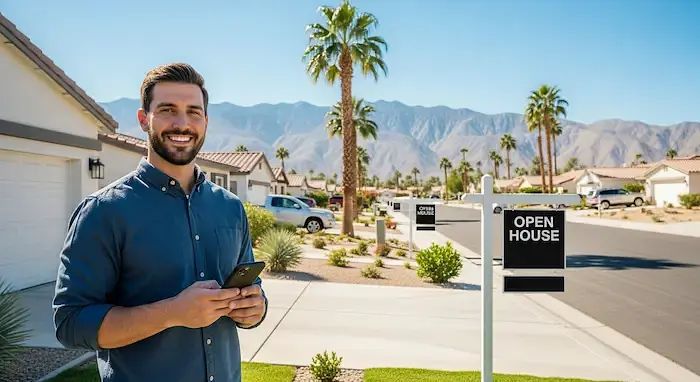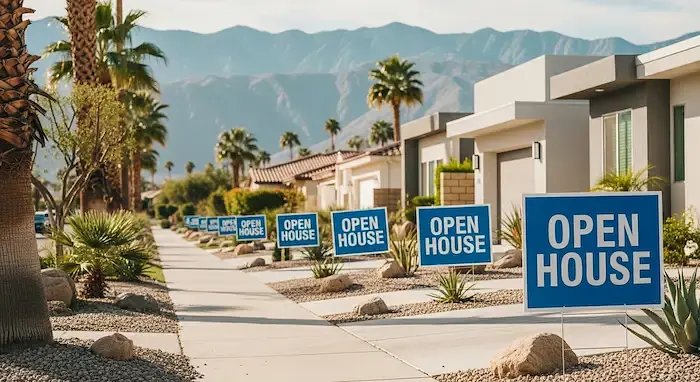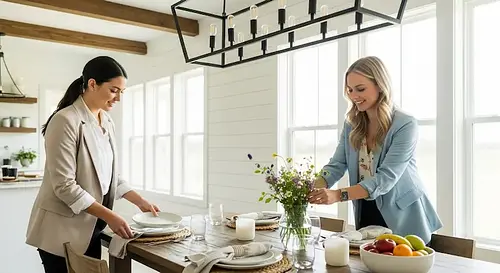How To Get 10 Listings In 30 Days With Open Houses
Want more listings without buying leads or cold calling? Discover how one agent tripled his business by hosting 100 open houses in 100 days—and landed 10 listings in his first 30 days alone. Here’s exactly how he did it (and how you can too).

Written by Seth Cox
Jul 19, 2025 / Open house marketing
For many agents, open houses are treated like a buyer-only tool. But when used the right way, they can become one of the most effective listing machines in your real estate playbook.
Just ask Peyson Robertson, a young agent in Palm Springs who nearly left the industry after hitting a slump. Instead of quitting, he launched a wild experiment: 100 open houses in 100 days. The result? His production tripled in one of the toughest markets in over a decade.
This article isn’t just a motivational story—it’s a blueprint. We’ll break down the exact steps Peyson used to turn open houses into a predictable pipeline for listings, show you how to replicate it in your market, and share tactical strategies that go far beyond “put up a few signs and hope someone walks in.”
Let’s dive into why open houses still work—and how to make them work for you.
From 0 to 10 Listings in 30 Days with Open Houses
After a promising start to his career, the deals dried up. The market slowed. His pipeline emptied out. Like many agents at the time, he started wondering if he was in the wrong industry—or just in the wrong strategy.
Instead of giving up, he tried something radical: 100 open houses in 100 days.
No paid ads. No fancy CRM. Just showing up, every day, in the desert heat of Palm Springs, California—with signs, flyers, and a phone full of follow-up notes.
What started as an experiment turned into a full-blown transformation.
- In June, he had zero escrows
- In July, he had 10 deals in escrow
- By year’s end, he had closed 26 transactions, tripling his previous year’s production
Instead of treating open houses like weekend events, Peyson treated them like a storefront—a daily opportunity to build visibility, credibility, and real relationships. He stayed in one location for days at a time, letting neighbors get familiar. He role-played daily with his team to sharpen scripts. He followed up with custom videos. He never asked if people had agents. And he never missed a chance to add value.
Most agents sit two open houses a month and call it a strategy. Peyson sat two a day—and turned it into a business.
The “100 Open Houses in 100 Days” Strategy (And Why It Works)
He started small. Three agents. One listing at a time. If their brokerage didn’t have a property available, they’d ask other agents. Eventually, they built a reputation—so much so that over 30 agents began calling them to host open houses for new listings.
But what really made the strategy work wasn’t the volume. It was the structure.
Here’s what Peyson and his team did differently:
- They hosted the same open house 7+ days in a row. This repetition created name recognition with neighbors and reinforced local market authority. One neighbor who used to just wave from the driveway eventually stopped to chat—and later listed with them.
- They showed up in extreme weather. 120-degree desert heat? Didn’t matter. They brought extra clothes and cold towels. The message was clear: we’re out here, no matter what.
- They ran open houses like consultations. Instead of pitching the home, they used the listing to start a conversation—asking visitors what they really wanted and texting personalized follow-ups right after they left.
- They followed up with personal video messages. No fancy tech—just an iPhone selfie video that recapped the conversation and offered helpful next steps. It was simple, human, and highly effective.
- They practiced every day. Each morning on Zoom, the team would roleplay actual open house conversations—especially the ones that didn’t go well. If someone failed to get a phone number the day before, they’d recreate that moment so the team could break it down, improve it, and learn from it together.
And while Peyson’s numbers are extraordinary, the core idea is repeatable for any agent willing to commit:
- Pick a geographic area you know and want to dominate
- Host open houses in that zone as often as possible
- Engage neighbors before, during, and after
- Follow up relentlessly with value—not desperation
- Repeat daily until the listings come to you
It’s in the consistency, positioning, and execution.

Step-by-Step: How Peyson Got 10 Listings in 30 Days from Open Houses
Here’s the exact breakdown of how he turned open houses into a listing pipeline:
1. He Picked the Right Neighborhoods—And Stayed There
“After a few days, the neighbors started recognizing me. One went from a polite wave to a full conversation—and later listed with me.”
2. He Turned Open Houses into Listing Consultations
“We never tried to sell the house. We used it to figure out what they actually wanted—and then we helped them get it.”
3. He Leveraged Signs for Seller Visibility
“I had people text me pictures of my signs from across town. It became passive branding that turned into active conversations.”
4. He Followed Up with Personalized Videos
“I tried BombBomb and stopped using it. The iPhone video was more authentic—and it actually got responses.”
5. He Practiced Daily, So He Could Convert on the Spot
“It’s crazy how many leads came the next day after we role-played a failed convo. You fix it once, and it keeps paying off.”
6. He Treated Every Day Like a Launch
“Even if we had zero walk-ins, someone always saw the story, the signs, or got the invite. It all adds up.”
Together, these steps helped Peyson turn daily open houses into a repeatable listing engine—even in one of the most challenging markets in years.
Hosting the Same Open House for 7+ Days Worked Better
Why? Because visibility compounds. And in real estate, familiarity builds trust.
“After day three, neighbors started waving. After day five, they’d stop and talk. By day seven, they were asking for help listing their home.”
When you stay in one location for several days, you're no longer just "that agent hosting today’s open house." You become part of the neighborhood. Sellers see your signs every morning. They recognize your car. They start to associate you with the local market—even if they never walk through the door.
Here’s what this approach unlocks:
- Increased brand recognition with neighbors and passersby
- Higher chance of seller conversations over time
- More efficient use of signs and setup effort
- Time to study and master the home and surrounding comps
- Ability to prospect surrounding homes throughout the week
“You can’t buy that kind of trust. You have to build it. And showing up every day is how you do it.”

How Peyson Used Social Media, Signs, and Scripts to Attract Sellers
His philosophy: if you’re doing the work, make sure people see it.
Here’s how he made that happen every day:
Social Media Stories that Created Perceived Activity
Even if the open house had zero traffic, his followers saw someone who was always active, always showing homes, and clearly working hard.
“I got more referrals from my sphere just by showing up on stories every day. People assume you're crushing it—and they want to work with a winner.”
This daily documentation positioned Peyson as the go-to agent in his market—even to people who never attended an open house.
Big, Branded A-Frame Signs That Flooded the Neighborhood
“Neighbors would text me photos of my signs like, ‘Saw you on the way to work again!’ That’s how I knew it was working.”
For sellers, these signs signaled consistency, visibility, and hustle. Over time, they came to associate his name with movement—even if they never stepped foot inside the home.
Open House Scripts Focused on Consultation, Not Conversion
Peyson asked better questions:
- “Is a 3-bedroom what you’re looking for?”
- “What would be missing from this home for it to be the right fit?”
- “Would it help if I texted you a few better matches nearby?”
“We never asked if they had an agent. We never handed them a card. We just tried to solve their problem—and that’s what they remembered.”
The big takeaway? It wasn’t any one tactic that brought in the listings. It was the combination of consistency, visibility, and value. Social media showed effort. Signs showed presence. Scripts showed empathy. Together, they built trust.
And trust is what gets you listings.
How to Scale Open Houses On A Team
But he didn’t just add people. He added structure.
“We don’t just hand someone a lockbox and say ‘go host.’ We train like it’s a sport. Scripts, follow-up, video—we coach it all.”
Here’s how Peyson scaled the open house strategy without diluting the results:
Each Agent Builds a Geographic Farm
“If you know the HOA fees, builder quality, and floorplans, you’ll earn more trust in 30 seconds than most agents do in 30 minutes.”
Daily Roleplay Keeps Everyone Sharp
It’s collaborative, fast-paced, and often leads to wins within 24 hours.
“The number of times someone pulled a lead the day after roleplay is unreal. You fix one moment—and it changes your week.”
Shared Tools, Templates, and Checklists
Everything is built to make sure no part of the process gets skipped—whether you’re on day 1 or day 91.
Central Coordination, Individual Execution
“The agent still owns the relationship. We just give them the tools to make it repeatable.”
The result? A team that doesn’t rely on cold leads, expensive ads, or busy seasons.
They simply outwork the market—one open house at a time.
Final Thoughts: Why Open Houses Still Work for Getting Listings in 2025
But those same agents are often sitting one open house a month, handing out flyers, and hoping someone walks in.
Peyson Robertson proved a different approach is possible. In one of the toughest markets in a decade, he didn’t wait for the market to pick back up. He created his own momentum—by showing up every single day and treating every open house as a chance to add value, build trust, and be seen.
He didn’t just generate buyer leads...
He earned listings from neighbors. He built a local brand from scratch. And he tripled his business in the middle of a slowdown.
The takeaway?
Open houses still work—if you work them like a system, not a side project.
- Show up consistently.
- Know your market cold.
- Engage neighbors without pitching them.
- Post your effort.
- Follow up relentlessly—with value.






